Learn more about your hair type and the best hair care products to keep your hair looking its best. Papilla By Kim Lim lays it all out in this guide.
How to determine your hair type – A complete guide

When you think of the different types of hair, the first thing that probably pops into your mind would be the simplest hair terms — either straight or curly. However, did you know that there are up to 12 hair types? The different characteristics of our individual hair types call for different hair care routines to bring out our hair’s fullest (and shiniest) potential.
In addition, learning your hair type is only half the battle. It is also just as important to understand how the right hair products can help you to achieve the best hair care routine. Not every product will work for every hair type, so correctly identifying your hair type is key to determining the best care routine for your hair.
12 Types Of Hair
All you need is a mirror. Place your finger on the most basic characteristic of your hair that you see (straight, wavy, curly or coiled/kinky), then drag your finger down to the secondary characteristics in the rows underneath.
|
Type |
1 (Straight) |
2 (Wavy) |
3 (Curly) |
4 (Coiled/Kinky) |
|
A | Fine, Thin hair, Prone to oil | Fine (Has S-shape) | Fine, Loose curls | Tight, Springy coils |
|
B | Medium, Some volume | Medium (Has S-shape with some frizz) | Medium or Tight curls | Z-coils |
|
C | Coarse, Thick, Won’t hold curls | Coarse (Has S-shape & prone to frizz) | Tight, Thick curls | Very tight, Coarse coils |
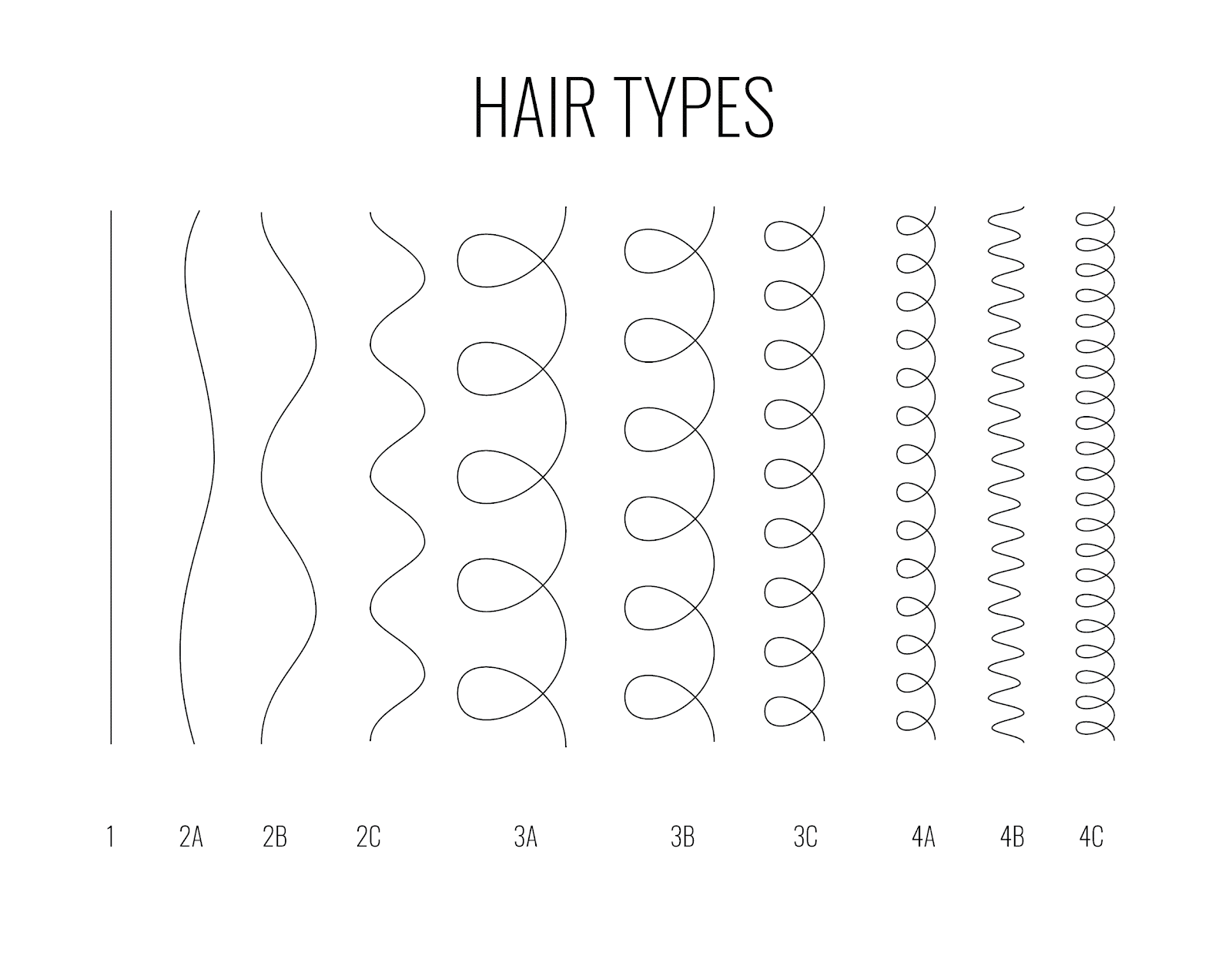
Curl Patterns of Each Hair Type
Type 1: Straight Hair
Straight hair (Type 1) lies flat, or straight on the scalp. As the hair’s natural oils are able to travel from the scalp to the ends, Type 1 hairs reflect the most sheen. There are three subcategories for straight hair:
- Type 1A hair is very straight and fine, with no hint of wave or curl. As it is so straight and fine, when the natural oils travel to the ends, it tends to cause it to look like oily hair. It is the rarest hair type and is common among women of Asian descent.
- Type 1B hair is straight, but has more volume than Type 1A. Its medium texture can generally hold curls giving the hair more texture and movement.
- Type 1C hair is straight and is usually coarse and thick, which can result in frizzy hair depending on the environment or climate. When air-dried, this hair type can achieve a tousled look, while still lying flat on the scalp.
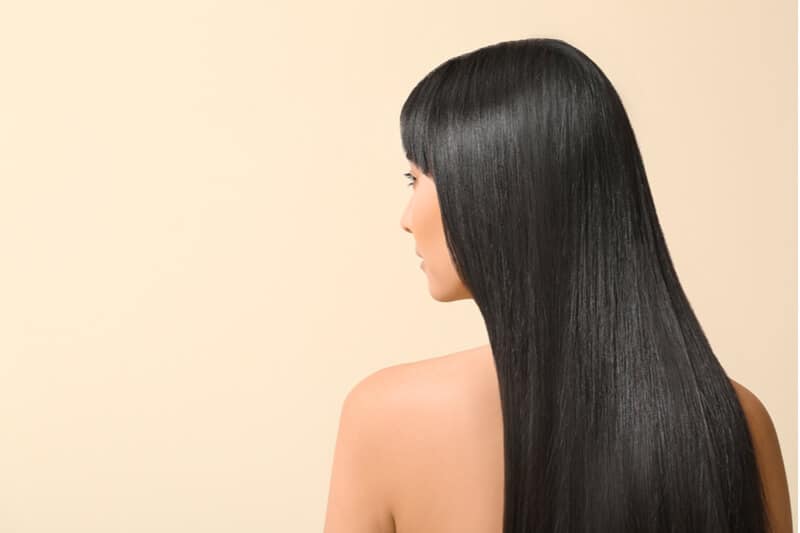
Here are a few tips on how to care for straight hair:
Wash Hair Regularly
While some people choose to skip washing their hair every few days, people with Type 1 hair should wash their hair regularly with shampoo to avoid oily-looking locks. Look for shampoos that are specially formulated for regular hair-washing and prevent oil build-up at the same time, like Papilla Scalp’s Minty Clean Shampoo.
For oily scalp problems, you can add Papilla’s Bio-Enzyme Scalp Mask to your hair care routine. The organic stem cell extracts formulation with added Salmon PDRN serves to unclog the hair follicles in your scalp, relieving your scalp of excess sebum and promotes better hair growth.
Use Natural Hair Products
While your hair may seem lifeless and dull due to a lack of volume, rather than overcompensating with a ton of products, you should focus on choosing products that contain natural ingredients like vitamin E or grapefruit seed oil to preserve your natural hair oils. This also provides your hair with a healthy boost without weighing it down.
Use Products To Keep Style Intact
When it comes to hairstyling, it is important to remember that Type 1 hairs are not able to hold curls as long as other hair types. To keep your curls intact, Type 1 hairs should use a finishing spray or hairspray to keep your curls intact.
Avoid Sleeping With Wet Hair
If you have Type 1 hair, it is best to avoid sleeping with wet hair to prevent hair frizz in the morning. However, if you need to sleep with damp hair, spray leave-in conditioner and pull your hair into a loose braid to prevent frizziness.
Type 2: Wavy Hair
Wavy hair (Type 2) hair types are naturally wavy and form an “S” shape. It is thicker than Type 1 hair types, and can be considered a medium between straight and curly hair. Because of its slight texture and shape, it is not as oily as Type 1.
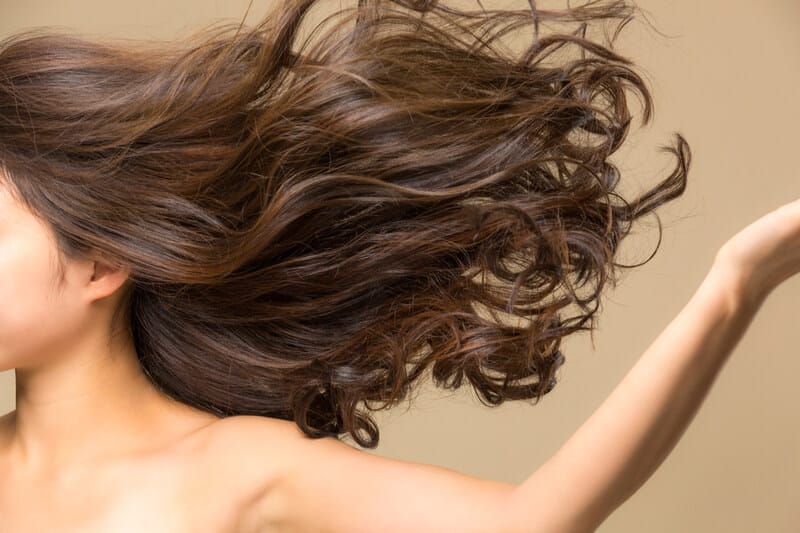
- Type 2A hair is fine and thin with individual strands forming an “S” shape when dry. It is easy to use styling products to curl or straighten Type 2A hair.
- Type 2B hair is wavy and slightly frizzier than Type 2A hair. When dry, individual strands create an “S” shape with some frizz.
- Type 2C hair waves start from the scalp and are thicker than other Type 2 subcategories. This coarse hair type is the most prone to frizz and forms an “S” shape when dry.
Type 3: Curly Hair
Curly hair (Type 3) hair types are naturally curly and classified as spiral curls. Type 3 hairs form ringlets that are naturally defined and more prone to dryness, tangles, frizz and breakage. As the follicle does not lay flat, this hair type tends to be dry.
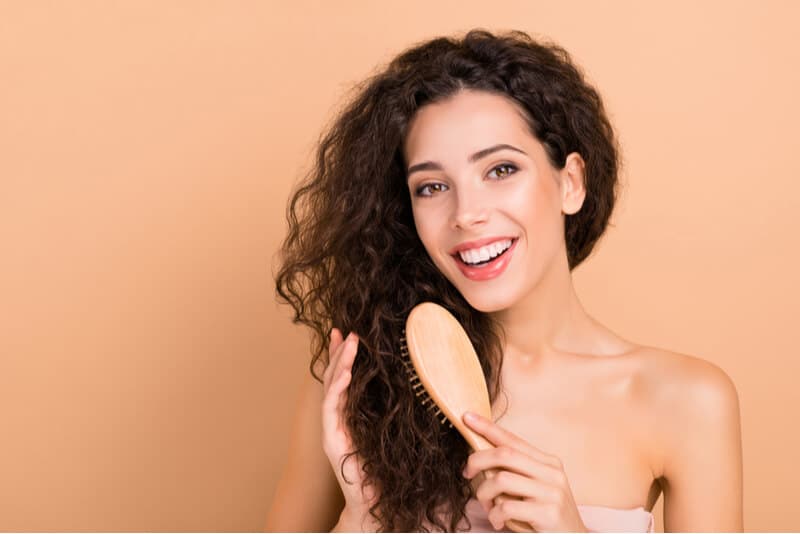
- Type 3A hair is fine and shiny with loose curls. This type of curly thick hair is easily defined without the use of styling products and is prone to slight frizz.
- Type 3B hair has curls that are medium to tight springy curls. Similar to Type 3A, it is prone to frizz.
- Type 3C hair has tight and thick curls. The curls of this hair type normally have a lot of texture.
As hair types 2 and 3 have slightly thicker textures and shape, they tend not to lay flat over the scalp as Type 1. They may also be less oily, thus caring for wavy or curly hair requires different techniques entirely to maintain healthy locks.
Hydration is Key
As Type 2 and 3 hairs have less natural hair oil, it is important to choose a sulfate-free shampoo to ensure that your hair is not drained of all its natural moisture. Sulfates in shampoos strip your hair of its natural oils and moisture causing frizzy and dull hair.
Hair products like Papilla’s Hair Regeneration Bio-Enzyme sulfate-free shampoo and conditioner are excellent in locking in moisture and keeping your hair hydrated.
To take your hair care routine a step further, you can apply Papilla’s Hair Regeneration Tonic with PhytoKines onto the clean scalp and massage it in to enhance your healthy hair growth cycle.
Avoid Heat Styling Tools
When it comes to styling your hair, people with Type 2 and 3 hair types should minimise the use of hot styling tools or chemical hair treatments that can damage the cuticle layer of your hair shaft. If you must use them, you should apply heat-protection products to protect your hair and keep it damage-free.
Type 4: Coiled/Kinky Hair
Type 4 hair types are most common among African Americans. Unlike Type 3 hair, coiled or kinky hair (Type 4) is tightly curled with defined ringlets (coils) and maintains its hair shape whether it is dry or wet. This hair type tends to be fairly coarse in texture, and is prone to damage by heated hair styling products.
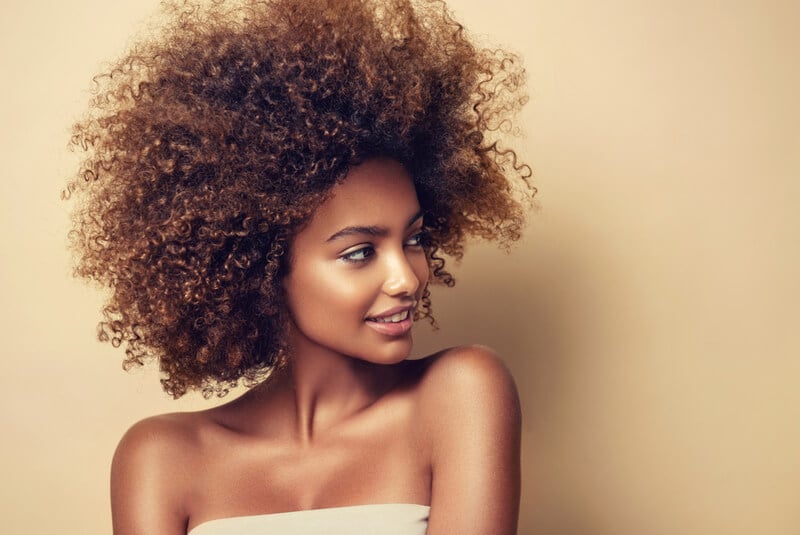
Due to the shape of individual hair strands, natural hair oils are unable to travel far down the hair shaft. People with curly or wavy hair types often experience dry and itchy scalps, and this can require further interventions to control the itchiness to restore healthy hair.
- Type 4A hair is usually in tight and springy coils. Hair strands of this type typically shrink down to half its length when dry. This type of hair has the most definitive curl pattern of the Type 4 hair category.
- Type 4B hair has tight curls in a Z coil (crimpy) pattern. Although it is less defined than Type 4A curls, it is clearer than Type 4C hair.
- Type 4C hair is densely packed and coarse. The curl pattern of this hair type is not defined and has a lot of shrinkage.
For Type 4 hair types, the emphasis should be on retaining moisture in the hair to keep it looking lush and healthy. Here are a few tips on how to care for kinky/coiled hair:
Moisturise Thoroughly
As Type 4 hairs are the most dry hair type, the key to caring for it properly is with moisture. Before you start washing your hair with shampoo and conditioner, try applying a moisturizing hair mask like Papilla’s Regeneration Scalp Hair Mask and work it into your hair.
After, follow up with a moisturising sulfate-free shampoo and deep conditioner to retain the silky sheen in your tresses. Your best options here can include Papilla Scalp’s Silky Shine Shampoo and Every Day Conditioner.
Dry Hair Correctly
When you step out of the shower, it is recommended to towel-dry your hair to remove any excess moisture. As this hair type is already dry, it is best to avoid using a hair or blow dryer to prevent frizz. Instead, air-dry your hair to reduce the risk of breakage and excessive dryness. A leave-in conditioner or hair oil helps provide added moisture and defines your natural curls.
Understanding Hair Porosity
Hair porosity is essentially your hair’s ability to retain and absorb moisture and products. There are three levels of hair porosity: high, medium and low. To determine your hair’s level of porosity, why not try out the float test?
The Float Test
After running your fingers through your hair or brushing, remove a single strand of hair. Fill up a bowl of water or a cup with room-temperature water and place the strand inside.
How to determine your hair’s level of porosity:
- High Level of Porosity: If your strand sinks to the bottom quickly.
- Medium Level of Porosity: If your strand sinks to the bottom slowly.
- Low Level of Porosity: If your strand floats.
If you know and understand your hair type and your hair porosity, then you will be able to craft a fitting routine to best meet your hair needs.
Are you using the correct hair care products for your hair type?

While selecting shampoo and conditioner may seem like a simple everyday decision, there are actually a myriad of factors that you should consider when selecting a hair product. Unique hair types aside, you can adopt good hair care practices in hot and humid weather conditions for shinier, silkier tresses wherever you go.
The best shampoo for curly hair may not work as well for straight hair, and vice versa. Not to mention, the scalp is often overlooked in most cases, and at Papilla, we believe that a healthy scalp is essential for healthier hair growth. Thus, it is important that you pick the right type of hair care products to ensure that your hair (and scalp) receives the treatment it deserves.
If you have followed our recommendations and still find that your hair’s condition is not improving, contact our friendly trichologists to find the best hair care routine for you.




